Spathiphyllum Schott
peace lily, snow flower, white sails, spathespathe:
(n) a large bract or bracts subtending and often enclosing an inflorescence
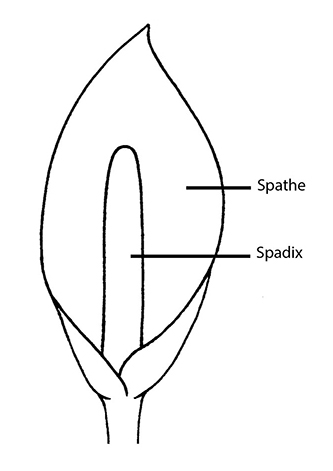 flower, spath
flower, spath
Araceae
Chlorophytum, Hymenocallis, Lagenandra, Peliosanthes
tropical Mexico through Central and South America, less frequently in Southeast Asia
Spathiphyllum wallisii Regel
The following may also be offered; they are typically used to produce hybrids and varieties
Spathiphyllum cannifolium (Dryand. ex Sims) Schott
S. floribundum (Linden & André) N.E.Br.
S. friedrichsthalii Schott
S. grandifolium Engl.
S. patini (R.Hogg) N.E.Br.
Spathiphyllum wallisii Regel is introduced into Puerto Rico.
not weedy
terrestrialterrestrial:
(adj) growing on land as opposed to living in water
, amphibiousamphibious:
(adj) of a plant able to live on land or in water
to rarely seasonally submergedsubmerged:
(adj) (syn. submersed) under water; submerged below the water surface
herb; may be hemiepiphytic or epilithicepilithic:
(adj) growing on the surface of a rock
Small to medium aroid. Rhizomes short, erect to creeping; stems compact, glabrousglabrous:
(adj) without hairs or scales
. Leaves in a loose basalbasal:
(adj) at or pertaining to the base, or point of attachment
rosetterosette:
(n) a radiating cluster of leaves, usually close to the ground at the base of a plant
 ; petioles erect, subequal or longer than bladeblade:
; petioles erect, subequal or longer than bladeblade:
(n) (syn. lamina) the flat, expanded part of a leaf, frond, or petal (excluding, e.g., the petiole)
 , sheathing, commonly winged below; leaf bladeblade:
, sheathing, commonly winged below; leaf bladeblade:
(n) (syn. lamina) the flat, expanded part of a leaf, frond, or petal (excluding, e.g., the petiole)
 oblongoblong:
oblongoblong:
(adj) two to four times longer than wide, with +/- parallel sides
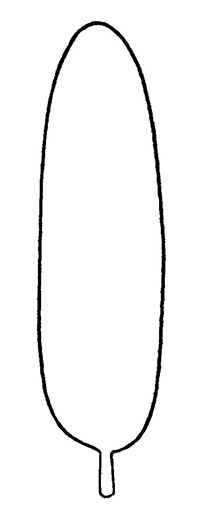 to ellipticelliptical:
to ellipticelliptical:
(adj) in the form of an ellipse (oval)
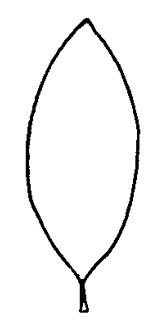 , or lanceolatelanceolate:
, or lanceolatelanceolate:
(adj) lance-shaped; widest point below the middle, tapering to the apex
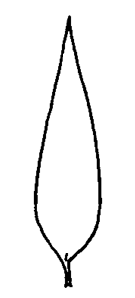 ; apexapex:
; apexapex:
(n) the point farthest from the point of attachment; the tip (often pointed)
cuspidatecuspidate:
(adj) with a short, sharp, abrupt tip (cusp)
to long- acuminateacuminate:
(adj) tapering gradually to a point and forming more or less concave sides
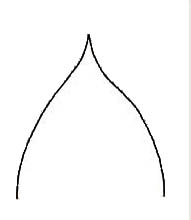 ; marginmargin:
; marginmargin:
(n) edge; rim
entire to ± undulateundulate:
(adj) (of, e.g., a margin) with a wavy surface; wavy in the vertical (up and down) plane
; venationvenation:
(n) the arrangement of veins in a leaf
pinnate, curving toward apexapex:
(n) the point farthest from the point of attachment; the tip (often pointed)
. Inflorescenceinflorescence:
(n) the arrangement of flowers on the floral axis
 a solitary, axillaryaxillary:
a solitary, axillaryaxillary:
(adj) in, of, or produced from an axil
spathespathe:
(n) a large bract or bracts subtending and often enclosing an inflorescence
 and spadixspadix:
and spadixspadix:
(n) a spike of small flowers borne on a thick, fleshy axis
 , ascending or erect; pedunclepeduncle:
, ascending or erect; pedunclepeduncle:
(n) the stalk of a flower cluster or inflorescence
subequal or longer than petiolepetiole:
(n) the stalk of a leaf
 ; spathespathe:
; spathespathe:
(n) a large bract or bracts subtending and often enclosing an inflorescence
 cucullate, ovateovate:
cucullate, ovateovate:
(adj) egg-shaped in outline; generally with the broad end at or near the base
 to ellipticelliptical:
to ellipticelliptical:
(adj) in the form of an ellipse (oval)
 or oblongoblong:
or oblongoblong:
(adj) two to four times longer than wide, with +/- parallel sides
 , apexapex:
, apexapex:
(n) the point farthest from the point of attachment; the tip (often pointed)
cuspidatecuspidate:
(adj) with a short, sharp, abrupt tip (cusp)
to long-acuminate, ± decurrentdecurrent:
(adj) extending downward, beyond the point of insertion
on pedunclepeduncle:
(n) the stalk of a flower cluster or inflorescence
, white, turning green in fruit; spadixspadix:
(n) a spike of small flowers borne on a thick, fleshy axis
 sessile or usually stipitatestipitate:
sessile or usually stipitatestipitate:
(adj) borne on a stipe or stalk
, erect, cylilndrical, shorter than spathespathe:
(n) a large bract or bracts subtending and often enclosing an inflorescence
 , cream color, usually fragrant. Berry conicalconical:
, cream color, usually fragrant. Berry conicalconical:
(adj) perfectly cone-shaped
to ovoidovoid:
(adj) egg-shaped in three dimensions
, apexapex:
(n) the point farthest from the point of attachment; the tip (often pointed)
rounded or conically attenuateattenuate:
(adj) narrowing gradually to a point
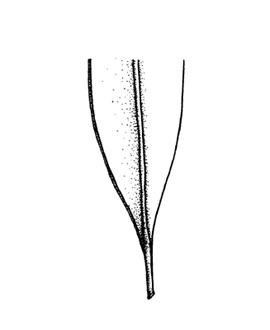 , green, 1-8-seeds per locule; seeds oblongoblong:
, green, 1-8-seeds per locule; seeds oblongoblong:
(adj) two to four times longer than wide, with +/- parallel sides
 , ellipsoid to ovoidovoid:
, ellipsoid to ovoidovoid:
(adj) egg-shaped in three dimensions
, slightly curved and ± reniformreniform:
(adj) kidney-shaped
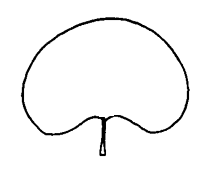 .
.
lowland primary forests, along streams, in open swampy areas, partially or periodically flooded forests
Spathiphyllum species are not true aquatics. S. wallisii is often used in aquaria and is often called S. tasson.